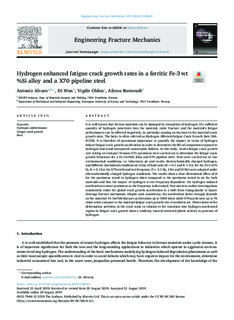| dc.contributor.author | Alvaro, Antonio | |
| dc.contributor.author | Wan, Di | |
| dc.contributor.author | Olden, Vigdis | |
| dc.contributor.author | Barnoush, Afrooz | |
| dc.date.accessioned | 2019-11-19T08:40:19Z | |
| dc.date.available | 2019-11-19T08:40:19Z | |
| dc.date.created | 2019-11-18T14:08:02Z | |
| dc.date.issued | 2019 | |
| dc.identifier.issn | 0013-7944 | |
| dc.identifier.uri | http://hdl.handle.net/11250/2629175 | |
| dc.description.abstract | It is well known that ferrous materials can be damaged by absorption of hydrogen. If a sufficient quantity of hydrogen penetrates into the material, static fracture and the material's fatigue performances can be affected negatively, in particular causing a reduction in the material crack growth rates. The latter is often referred as Hydrogen Affected-Fatigue Crack Growth Rate (HA-FCGR). It is therefore of paramount importance to quantify the impact, in terms of hydrogen induce fatigue crack growth acceleration in order to determine the life of components exposed to hydrogen and avoid unexpected catastrophic failures. In this study, in-situ fatigue crack growth rate testing on Compact Tension (CT) specimens were carried out to determine the fatigue crack growth behaviour for a Fe-3wt%Si alloy and X70 pipeline steel. Tests were carried out in two environmental conditions, i.e. laboratory air and in-situ electrochemically charged hydrogen, and different mechanical conditions in terms of load ratio (R=0.1 and R=0.5, for the Fe-3wt%Si, R=0.1 for the X70 steel) and test frequency (f=0.1 Hz, 1 Hz and 10 Hz) were adopted under electrochemically charged hydrogen conditions. The results show a clear detrimental effect of H for the specimens tested in hydrogen when compared to the specimens tested in air for both materials and that the impact of hydrogen is test frequencydependent: the hydrogen induced acceleration is more prominent as the frequency is decreased. Post-mortem surface investigations consistently relate the global crack growth acceleration to a shift from transgranular to Quasi-cleavage fracture mechanism. Despite such consistency, the acceleration factor strongly depends on the material: Fe-3wt.%Si features acceleration up to 1000 times while X70 accelerates up to 76 times when compare to the material fatigue crack growth rate recorded in air. Observation of the deformation activities in the crack wake in relation to the transition into hydrogen accelerated regime in fatigue crack growth show a tendency toward restricted plastic activity in presence of hydrogen. | nb_NO |
| dc.description.abstract | Hydrogen enhanced fatigue crack growth rates in a ferritic Fe-3 wt%Si alloy and a X70 pipeline steel | nb_NO |
| dc.language.iso | eng | nb_NO |
| dc.publisher | Elsevier | nb_NO |
| dc.rights | Attribution-NonCommercial-NoDerivatives 4.0 Internasjonal | * |
| dc.rights.uri | http://creativecommons.org/licenses/by-nc-nd/4.0/deed.no | * |
| dc.title | Hydrogen enhanced fatigue crack growth rates in a ferritic Fe-3 wt%Si alloy and a X70 pipeline steel | nb_NO |
| dc.type | Journal article | nb_NO |
| dc.type | Peer reviewed | nb_NO |
| dc.description.version | publishedVersion | nb_NO |
| dc.source.volume | 219 | nb_NO |
| dc.source.journal | Engineering Fracture Mechanics | nb_NO |
| dc.identifier.doi | 10.1016/j.engfracmech.2019.106641 | |
| dc.identifier.cristin | 1748895 | |
| dc.description.localcode | © 2019 The Authors. Published by Elsevier Ltd. This is an open access article under the CC BY-NC-ND license (http://creativecommons.org/licenses/BY-NC-ND/4.0/). | nb_NO |
| cristin.unitcode | 194,64,92,0 | |
| cristin.unitname | Institutt for maskinteknikk og produksjon | |
| cristin.ispublished | true | |
| cristin.fulltext | postprint | |
| cristin.qualitycode | 1 | |

